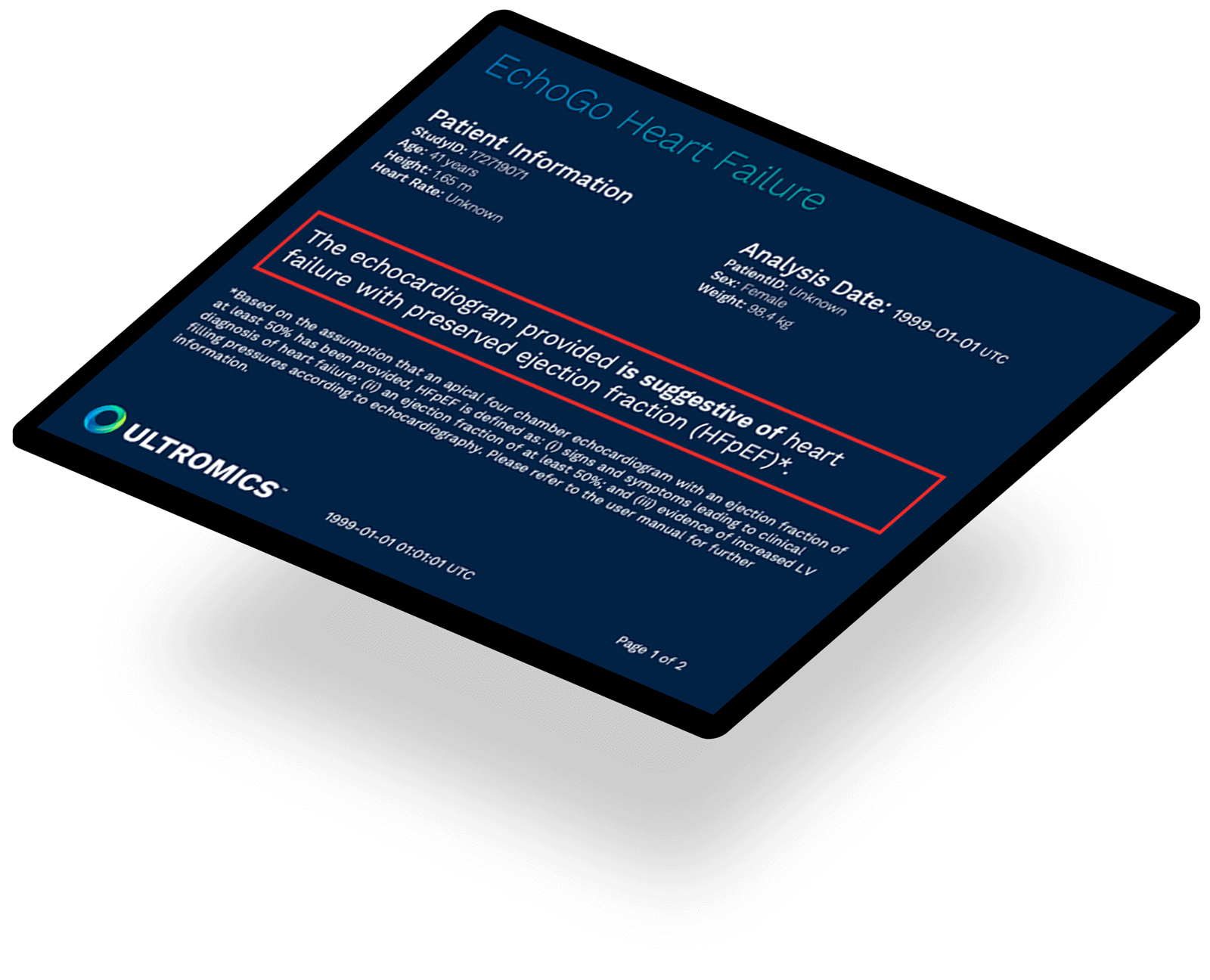Diagnose HFpEF with confidence
Precision detection of heart failure with preserved ejection fraction (HFpEF).

The greatest unmet need in cardiovascular medicine
With a rising population of heart failure patients putting unprecedented stress on the medical system, this “greatest unmet need in cardiovascular medicine” requires innovative and groundbreaking precision treatment strategies. 7

50% of heart failure patients have HFpEF
Heart failure-related costs and cases are expected to double by 2030.1

Up to 75% of HFpEF patients are a missed diagnosis
Missed diagnoses lead to increased hospitalizations and mortality.2

Up to 75% of HFpEF patients are a missed diagnosis
Missed diagnoses lead to increased hospitalizations and mortality.2

Half of all heart failure patients suffer from HFpEF. Understanding what it is, when it happens, and how to treat it remains the single largest unmet need in cardiovascular health.
Dr. Norman Stockbridge, Director of the Division of Cardiology and Nephrology at the Office of Cardiology, Hematology, Endocrinology and Nephrology at the U.S. Food and Drug Administration (FDA). 5

Precision HFpEF detection
EchoGo Heart Failure, built in collaboration with the Mayo Clinic, delivers precision heart failure detection using the power of AI from a single apical 4-chamber view of an echocardiogram.
- 90% accuracy in detecting HFpEF 3
- 25% increase in diagnostic accuracy from current clinical practice 3
- Reduced need for costly and invasive procedures 3


With recent advances in drug therapies that positively impact HFpEF outcomes, such as Sodium-glucose Cotransporter-2 (SGLT2) Inhibitors, it’s more important than ever to provide a fast and accurate HFpEF diagnosis. 4
But current clinical practices require time and skill to accurately predict outcomes, and even then, HFpEF can be missed.
EchoGo Heart Failure significantly reduces reporting time while improving accuracy, ultimately limiting the need for costly and more invasive procedures.6

Pioneering technology
Accurate
>90% accurate in detecting HFpEF.

Efficient
Requires only an echocardiographic Apical 4-Chamber Loop.

Vendor neutral
Connects with any system, anywhere.

Accessible
Cloud-based service accessible to all providers.

Quality
Ensure patients get the life-extending and life-saving treatment they need.

References:
- Urbich M, Globe G, Pantiri K, et al. A Systematic Review of Medical Costs Associated with Heart Failure in the USA (2014-2020). Pharmacoeconomics. 2020;38:1219-1236
- Sanders-van Wijk S, Aizpurua AB, Brunner-La Rocca HP, et al. The HFA-PEFF and H2FPEF scores largely disagree in classifying patients with suspected heart failure with preserved ejection fraction. European Journal of Heart Failure. 2021;23:838-840
- EchoGo Heart Failure FDA Submission
- Heidenreich AH, Bozkurt B, Aguilar D, et al. 2022 AHA/ACC/HFSA Guideline for the Management of Heart Failure: A Report of the American College of Cardiology/American Heart Association Joint Committee on Clinical Practice Guidelines. Circulation. 2022;79:263-421
- National Institute of Health. The FNIH Announces New Research Initiative to Identify More Precise Treatment Strategies for Patients Suffering from Heart Failure. www.nhlbi.nih.gov/news/2022/fnih-announces-new-research-initiative-identify-more-precise-treatment-strategies. 2022.
- Asch FM, Descamps T, Sarwar R, et al. Human versus Artificial Intelligence-Based Echocardiographic Analysis as a Predictor of Outcomes: An Analysis from the World Alliance Societies of Echocardiography COVID Study. Journal of the American Society of Echocardiography. 2022;35:1226-1237.e7
- Shah SJ, Borlaug BA, Kitzman DW, et al. Research Priorities for Heart Failure With Preserved Ejection Fraction: National Heart, Lung, and Blood Institute Working Group Summary. Circulation. 2020;141:1001-1026.
Curious about upcoming research and innovation?
Sign up to hear about the latest news.